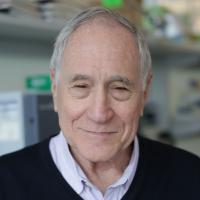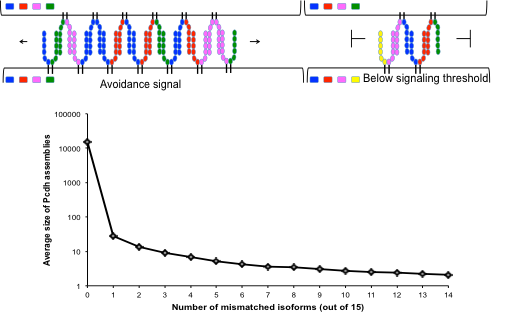ABOUT BARRY HONIG
Understanding the Brain’s Superglue
A scientific triple threat, Barry Honig, PhD, draws on biology, chemistry and physics to investigate sticky molecules that play a role in major brain diseases.

Barry Honig, PhD, studies nature's superglue: molecules called cadherins and protocadherins that help cells in our body recognize each other and, when appropriate, stick together. Crucial for proper brain development, these molecules may also be key to understanding brain diseases ranging from epilepsy to autism.
"These are fundamentally important molecules that dictate how our brain cells connect to each other," said Dr. Honig, a principal investigator at Columbia's Mortimer B. Zuckerman Mind Brain Behavior Institute as well as professor of biochemistry and molecular biophysics, systems biology and medicine and director of the Center for Computational Biology and Bioinformatics at Columbia University Medical Center.
To better understand the role of cadherins in forming proper brain connections, Dr. Honig has set up an unusually diverse laboratory. Some of his colleagues are biologists who spend their days carrying out hands-on experiments in close collaboration with Lawrence Shapiro, another principal investigator at Columbia’s Zuckerman Institute. Others are theorists, experts in creating computer simulations of how molecules behave, who never touch a test tube.
This emphasis on interdisciplinary research stems from Dr. Honig’s own background. He is, in a sense, an accidental neuroscientist. His first experiences in science were in physics and chemistry. His first published research papers explored quantum mechanics, specifically the electrical properties of organic molecules and their interaction with intense laser beams.
After earning a degree in chemical physics he developed an interest in biology which has grown dramatically over time, in part through close interactions over many years with his colleagues at Columbia.
Honig’s earliest forays into biology led to the discovery that electric fields created by proteins are important for the pigments our eyes use to detect color. He then developed software tools based on fundamental physics to calculate these fields. Essentially every structural biologist studying proteins uses these or derivative tools.

Above: Chain termination model for neuronal recognition based on zipper-assembly. Upper panel: Left – In apposed neurites shown with four identical isoforms, chain assembly is limited only by copy number. Right - A single isoform mismatch quickly terminates the chain. Lower panel: Monte-Carlo calculations demonstrate a striking dependence of Pcdh assembly size on the number of mismatched isoforms between interacting cells. Calculations assume 1000 copies per isoform. Note the step-function shape of the curve (Credit: Barry Honig).
Honig’s forays into biology intensified when he came to Columbia in 1981. He had tried to get a job in other biology departments at different institutions – but the biologists in those departments saw him as a physical scientist and were reluctant to recruit him, while the chemistry and physics departments saw him as “too biological.” Fortunately Isidore Edelman, then chair of Columbia’s department of biochemistry and molecular biophysics recognized the value of interdisciplinary research and of the value of theoretical and computational methods in modern biology.
Compared to physics and chemistry, biology was messy. But the problems biologists thought about, Dr. Honig realized, were especially intriguing to him.
“Biology is treasure trove of fascinating things to work on,” he said. “Biologists ask big questions regarding phenomena for which, in many cases, we don’t have the foggiest understanding. This of course is particular true about the brain”
Honig’s interest in cadherins began in 2001 when Lawrence Shapiro, approached him about cadherins. They decided to form a partnership to study these molecules, fusing Dr. Shapiro’s expertise in experimental structural biology and Dr. Honig’s expertise in computer simulations.
“We started thinking together and asking questions together,” said Dr. Honig.
Their initial work has already revealed some clues as to how the brain forms connections. The long branches that extend from brain cells are covered with different combinations of cadherin molecules. Like grooves on a key that fits only a specific lock, these patterns of molecules dictate that branches from different cells can connect to each other, while branches from the same cell cannot.
“All my life I have studied the fundamental physical principles that govern the behavior of molecules,” he said. “As a physicist, chemist and biologist, I now have the opportunity to apply those principles to the understanding of neuronal development. I never dreamed when I started my career that the study of somewhat esoteric molecular problems would allow me one day to address fascinating problems associated with the brain and to become part of such an exciting community of investigators.”
AWARDS AND AFFILIATIONS
-
Howard Hughes Medical Institute
Investigator (2000)
-
American Association for the Advancement of Science
Fellow (2006)
-
National Academy of Sciences
Member (2004)
-
American Academy of Arts and Sciences
Member (2007)
-
American Society for Biochemistry and Molecular Biology
DeLano Award in Computational Biosciences (2012)
-
The Protein Society
Christian B. Anfinsen Award (2012)
-
National Academy of Sciences
Alexander Hollaender Award in Biophysics (2007)
-
Biophysical Society
Founders Award (2002)
Selected Publications
-
Structural Basis of Diverse Homophilic Recognition by Clustered α- and β-Protocadherins.
Goodman KM, Rubinstein R, Thu CA, Bahna F, Mannepalli S, Ahlsén G, Rittenhouse C, Maniatis T, , Shapiro L
Neuron.2016 May 18
-
Molecular logic of neuronal self-recognition through protocadherin domain interactions.
Rubinstein R, Thu CA, Goodman KM, Wolcott HN, Bahna F, Mannepalli S, Ahlsen G, Chevee M, Halim A, Clausen H, Maniatis T, Shapiro L,
Cell.2015 Oct 22
-
Single-cell identity generated by combinatorial homophilic interactions between α, β, and γ protocadherins.
Thu CA, Chen WV, Rubinstein R, Chevee M, Wolcott HN, Felsovalyi KO, Tapia JC, Shapiro L, , Maniatis T
Cell.2014 Aug 28
-
Transforming binding affinities from three dimensions to two with application to cadherin clustering.
Wu Y, Vendome J, Shapiro L, Ben-Shaul A,
Nature.2011 Jul 27
-
Classical electrostatics in biology and chemistry.
Honig B, Nicholls A
Science.1995 May 26
